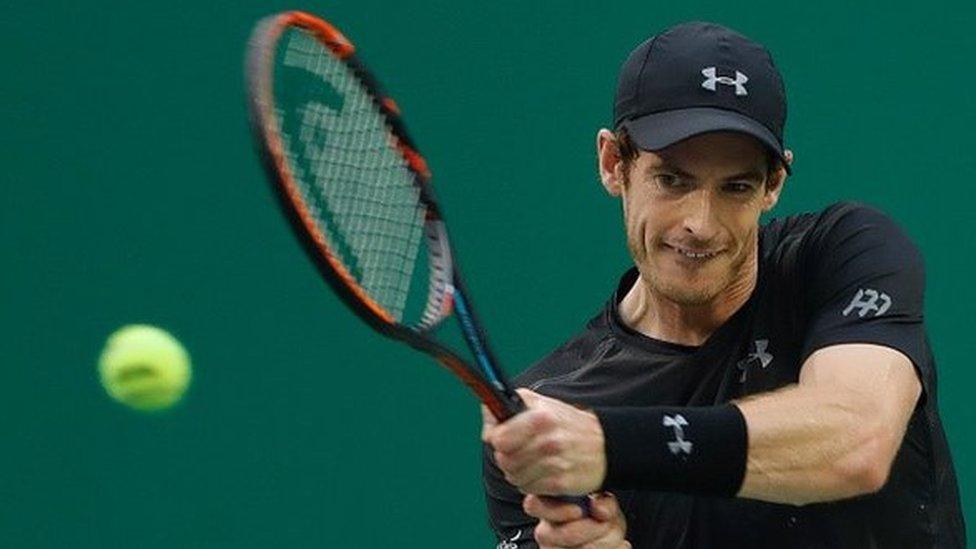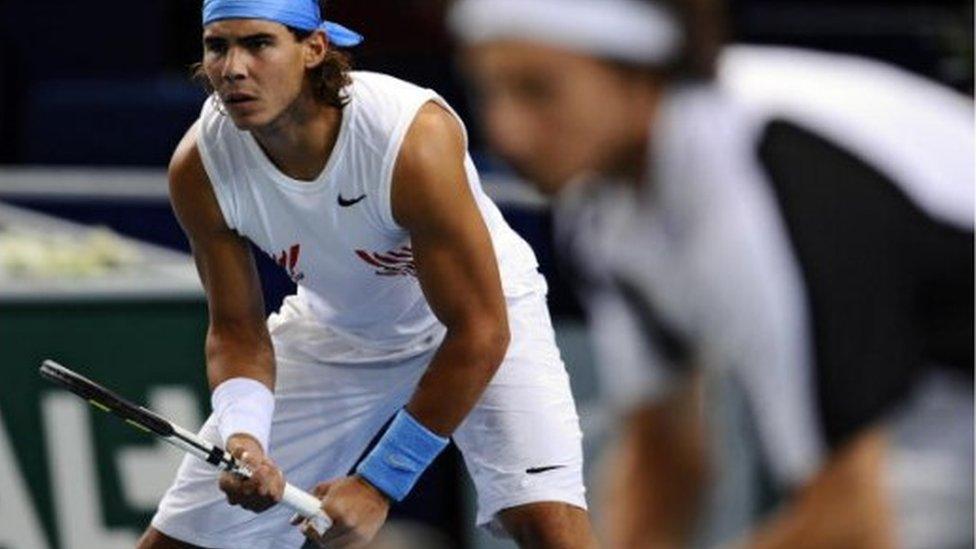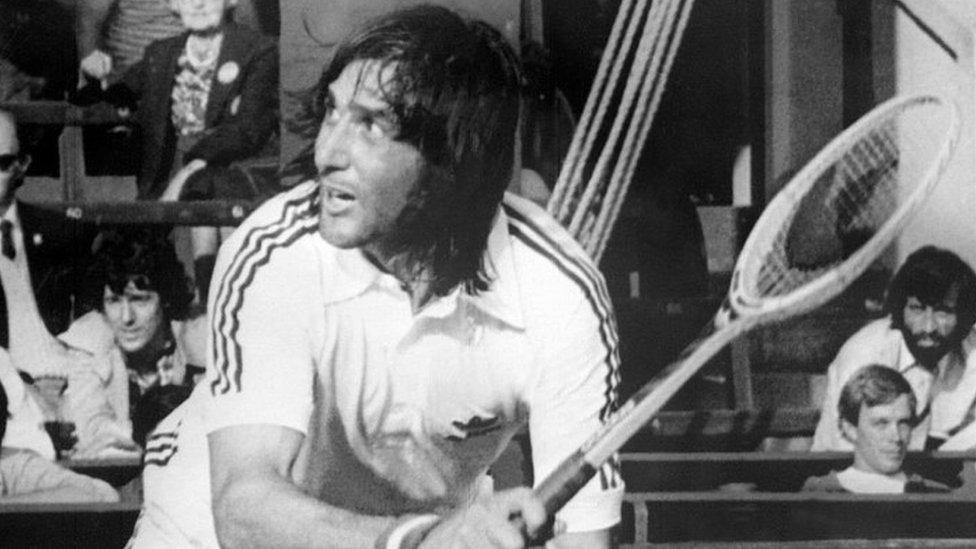Andy Murray can net sponsor boost after reaching top of tennis
- Published

As Andy Murray is set to be officially crowned the world's leading male tennis player he has secured himself another piece of personal and British sporting history.
Not only is it another achievement to rank alongside his three Grand Slam wins and two Olympic gold medals, but it's also the first time a British man has topped the ATP world rankings since they were launched 43 years ago.
Murray needed to reach the final of the Paris Masters to replace Novak Djokovic - and did so when Milos Raonic pulled out before their semi-final.
He can now rank himself alongside legends from the 1970s, such as Nastase, Borg, McEnroe and Connors, through to current stars Federer, Nadal and Djokovic.
His status will be official when the ATP releases its latest rankings on Monday.
According to other current stats from the ATP, the 29-year-old made more than $10m (£8m) in prize money this year.
But according to figures from business publication Forbes, the Scot made some $15m from endorsements alone last year, a figure which eclipses his playing earnings.
'Brand value'
And it is his off-court earnings where the real financial potential now lies.
"Being world number one will significantly enhance Murray's brand value," says branding expert Anastasia Kourovskaia, who has worked with a number of big names in the leisure and sporting industry.
"He has always been the challenger, and associated with having tenacity, motivation, and having goals, and not giving up. Also of being the rebel - the outsider.

Rafael Nadal changed his previous buccaneering image when he became world number one
"All the above attributes have now received validation, and shown to have paid off, but he will be in the position of not being the challenger any more."
She adds: "We will now have an interesting situation to see which direction his brand will go in. And it will be interesting to see if it has any change on his behaviour or the way he acts on court."
Indeed, one tennis champion who changed his on-court appearance after he ascended to the number one spot was Spanish star Rafael Nadal. Over the course of 2008 and 2009 his image moved from piratical to practical, as he shed the sleeveless shirts and long pants for more regulation polo shirt (and also round necked t-shirts) and shorts.

ATP world number one

Rankings first introduced in August 1973
First number one was Romanian Ilie Nastase (pictured)
25 different players have previously been number one
Previous number one was Novak Djokovic
Roger Federer has spent most weeks at the top, 302
Shortest reign was Pat Rafter's one week in 1999

'Establishment'
Ms Kourovskaia says that Murray could continue to present himself as the challenger brand, but that might seem "less authentic" now that he is in the top spot.
She says that should he want to make a change into a more establishment brand, he was well placed, with his own AM marketing logo already in place, as well as a strong family-man image after his marriage to Kim Sears and the birth of his first child.
Murray currently has a small number of companies that he has deals with.

One of Murray's current sponsor partners is Standard Life
In January 2015 he left Adidas for a four-year deal with US kit-maker Under Armour, believed to be worth around £15m. He also has agreements with financial services firm Standard Life and tennis racquet maker Head.
And he added luxury car marque Jaguar to his roster at the beginning of this year, to complete a quartet of partnerships.
"If, as I suspect, he accepts a more establishment role, that will indeed open up more potential sponsorship opportunities," says Ms Kourovskaia.
"Bu it may be that he and his management are happy with the small number of endorsements that he has."
She also says that being number one could make him more of an international brand than a British one.
'Powerful association'
Murray's agent is Matt Gentry, who has worked with him since 2009 when he was part of Simon Fuller's XIX Entertainment. Gentry is now managing director of Murray's own management company, 77.
Ms Kourovskaia said it was certain that Murray will talk over his future strategy with his management team, but that any sponsorship collaborations would have to be tight-knit for both the player and the firms involved.

Murray's management team is led by Matt Gentry
That is, any new company he signs with should not have a vast roster of other famous personalities that it is backing, and there also would have to be an understanding that Murray is not going to sign a huge glut of new deals either.
"That way the Murray image is not diluted," says Ms Kourovskaia.
"The fact that he does not already have many sponsors is an attraction to any other potential partners, as it means they can still create powerful associations with him."
'Love of tennis'
She says that one immediate beneficiary of Murray's ascent will be Under Armour.
"It was also a challenger brand, and they are well positioned with him," she says. "They will feel validated by signing him.
"But if he decides to go down an 'establishment' route, then they will also be able to capitalise on the fact that they have come with him from outsider to number one."

Murray will be looking to win many more trophies before retiring
That Under Armour deal will see Murray through into his early 30s, and Ms Kourovskaia says he may already be planning ahead for a life post-tennis.
"He seems to me to be someone who plans well into the future, and although I am sure he has no intention of stopping playing any time soon, he and his team will already be considering that day," she says.
"He does genuinely love playing and love tennis, and he can be a great ambassador for the sport, continuing through his time now as number one, for the rest of his playing career, and then into retirement."
That, she says, would then be the time - should he desire - to build on that ambassadorial presence and launch his own AM-branded products, such as tennis academies.
Murray will be hoping for a lengthy reign. After all, the vast potential branding opportunities could count for nothing if he only lasts a short time at the top, like Carlos Moya, who reigned for two weeks, or Pat Rafter, who lasted just one.